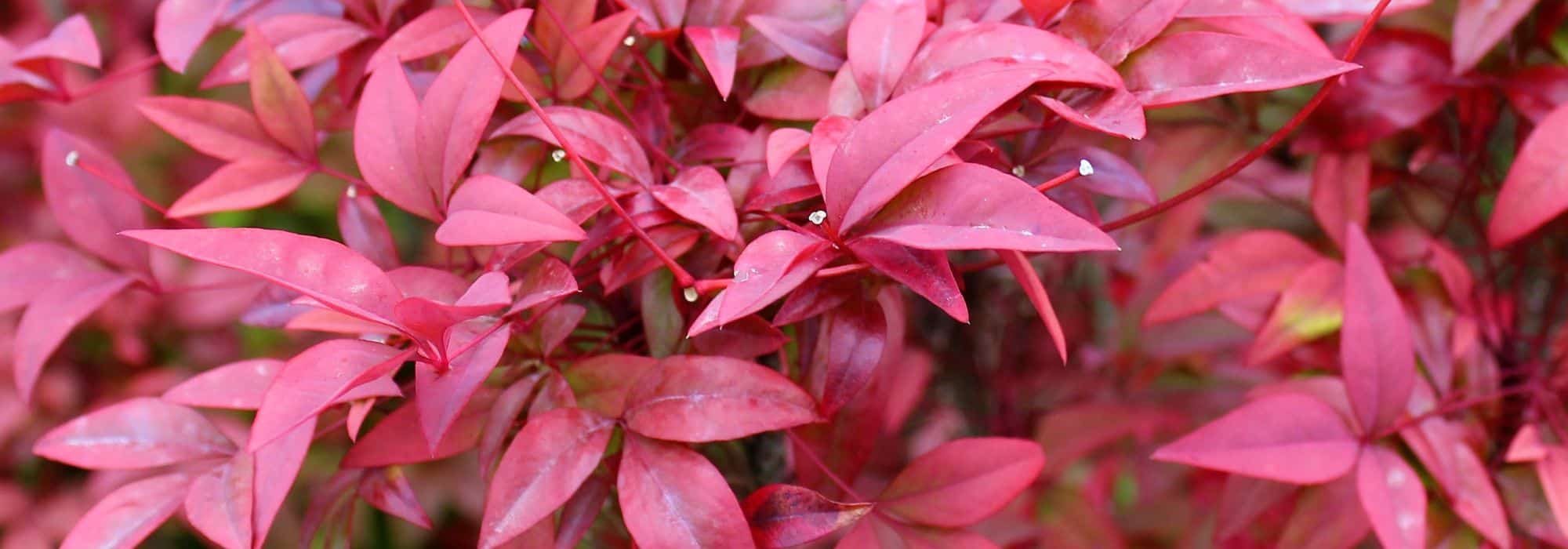
Growing a Nandina in a Pot: All Our Tips
to decorate the balcony or terrace
Contents
The Nandina domestica, also known as Sacred Bamboo, is an evergreen bush with colourful and changing foliage, offering year-round decorative appeal. With its green, red and purple leaves, white summer flowering and red berries, it’s perfect for enhancing balconies, terraces and gardens.
When grown in pots, Nandina adapts well to small spaces, and its moderate growth makes it an easy-care plant. Follow this detailed guide to successfully grow Nandina in pots and enjoy its natural elegance throughout the seasons.
What are the main attractions of potted Sacred Bamboo?
The Nandina domestica is a compact bush, ideal for small spaces like balconies, terraces or patios. Despite its nickname of sacred bamboo, it doesn’t produce suckers and its moderate growth makes it an easy bush to contain.
Growing it in a pot offers great mobility: You can move the pot to adjust exposure according to the seasons or to protect the plant in winter, particularly from cold winds.
Moreover, in a pot, maintenance, watering needs and plant monitoring are easier to control.
With foliage that changes colour throughout the seasons (green in spring, then fiery red in autumn and winter) the nandina adds an aesthetic touch all year round, to enhance a balcony, create a focal point on a terrace or compose a container display.
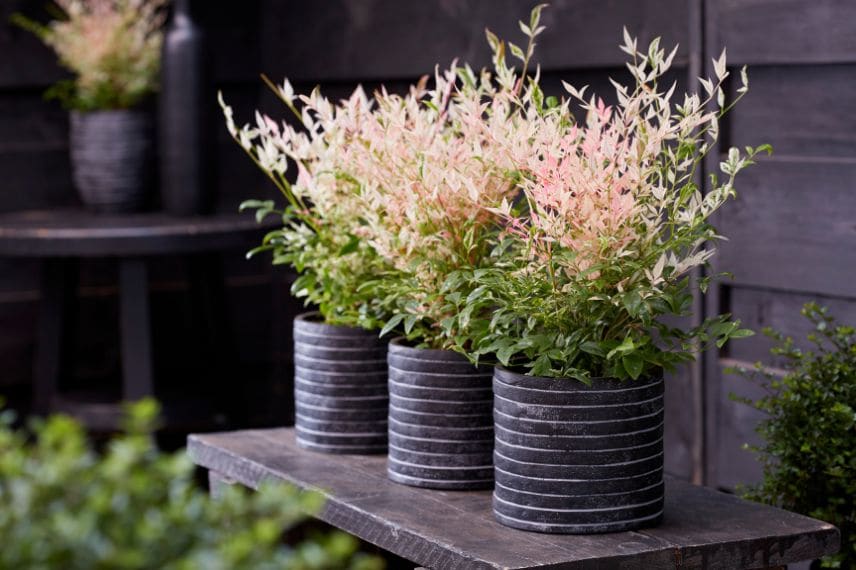
Nandina domestica ‘Twilight’ in spring, when young shoots are variegated with white and pink (photo and copyright by Plantipp)
Which variety of Nandina to choose?
For container or trough cultivation, opt for compact small varieties of Nandina domestica, which are better suited to this growing method, such as:
- Nandina ‘Gulf Stream’: Reaching 1 m at ripeness, this sacred bamboo has a dense, compact habit, with foliage that turns purple-pink in spring, green-bronze in summer, then orange-red in autumn and winter.
- Nandina ‘Fire Power’ : A small bush measuring 40-60 cm when mature, this petite variety boasts stunning evolving foliage: bright red in spring, turning blue-green in summer before turning crimson in autumn.
- Nandina ‘Lemon Lime’: This cultivar (60-80 cm tall) stands out for its bright chartreuse green foliage. Unlike other varieties, it does not take on red hues in autumn and winter, giving it a fresh, bright appearance all year round.
- Nandina ‘Twilight’: Its foliage, variegated with white and pink, is highly decorative and perfect for an original touch.
Tip: Combine several varieties of Sacred Bamboo for a colourful and dynamic effect all year round!
→ Also discover our article: “Sacred Bamboo: The Most Beautiful Nandina to Grow in Pots“.
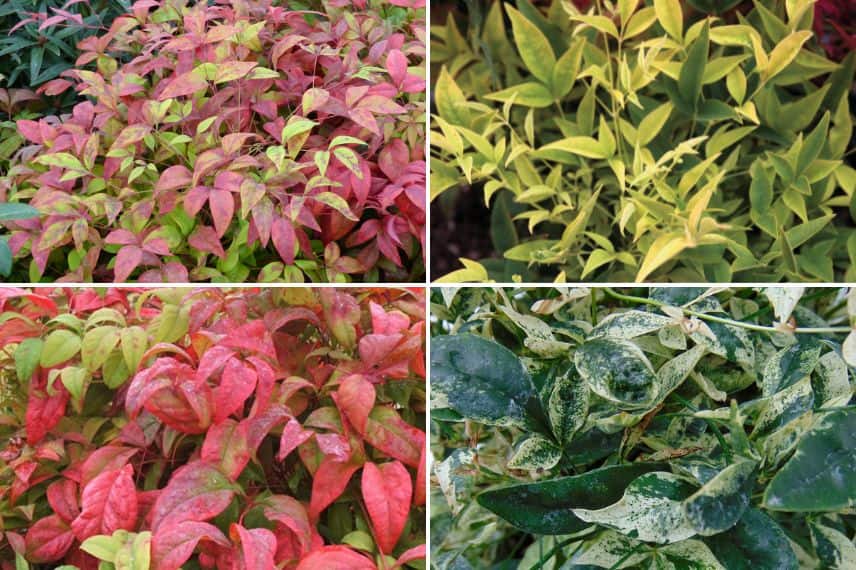
Left: Nandina ‘Gulf Stream’ and ‘Fire Power’ / Right: Nandina ‘Lemon Lime’ and Nandina ‘Twilight’
When to plant Nandina in a pot?
The Nandina domestica is best planted:
- In spring (March to May): This season is ideal for rapid growth and good root establishment before summer.
- In autumn (September to November): Perfect for warmer regions, this period allows for good root establishment before winter and strong regrowth the following spring.
Avoid planting in midsummer if possible, as the heat can stress the plant and make watering more demanding.
Which pot to choose for Sacred Bamboo?
The choice of pot depends on your watering habits and personal taste. However, there are a few criteria to consider to ensure good growth for the sacred bamboo, even though its growth is rather slow.
- Pruning: Minimum 30-40 cm in diameter and depth. A pot that’s too small would limit its growth. Conversely, an oversized pot may cause stress to the plant.
- Material:
- Terracotta: This material promotes better root aeration, though the compost may dry out faster and require more regular watering.
- Plastic or resin: Lighter in weight, this type of material makes it easier to move the pot, especially for winter shelter. Note that it also retains more moisture.
- Drainage: The pot must have holes at the bottom to prevent water stagnation and root rot. Also place a layer of clay pebbles at the base.
- Tip: Use a saucer under the pot to avoid excess moisture while maintaining good water levels.
How to plant a Nandina or Sacred Bamboo in a pot?
Required Materials
- A perforated pot of Ø 30-40 cm.
- Clay pebbles, gravel or small stones to improve drainage.
- A rich, well-draining potting compost.
- Compost or a slow-release organic fertiliser.
- A trowel and gardening gloves.
Which growing medium to use?
Nandina prefers light, slightly acidic and well-drained soil. The ideal mix:
- 50% horticultural compost
- 30% garden soil or compost
- 20% sand or perlite to improve drainage
Steps for planting Nandina
1- Place a layer of clay pebbles at the bottom of the pot to facilitate water drainage.
2- Fill the pot halfway with the compost mix.
3- Remove your Nandina from its pot and place it in the centre, gently spreading out the roots.
4- Fill the remaining space with compost, lightly firm down and water generously.
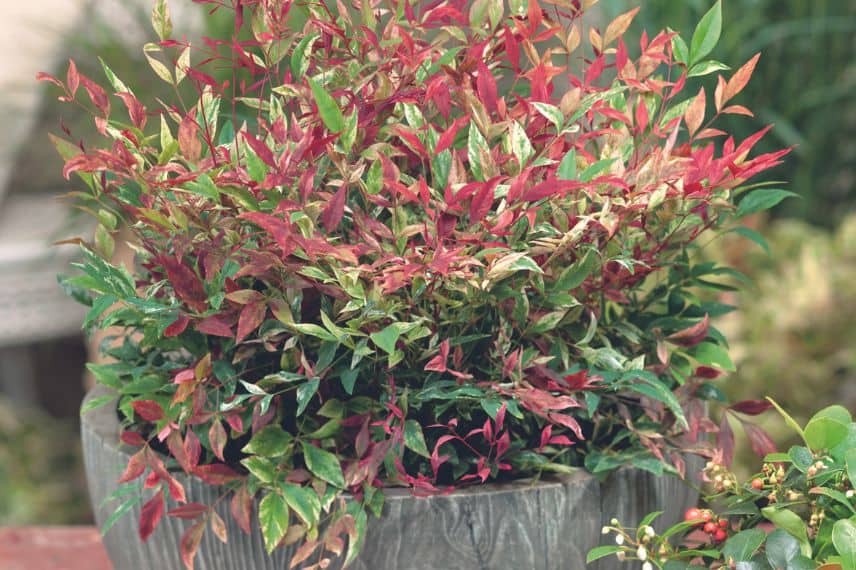
Where to place sacred bamboo in a pot?
Nandina is an adaptable bush, capable of growing in various exposures, but certain conditions allow it to thrive and display its most beautiful colours.
- Partial shade to gentle sun: This is the ideal exposure! Nandina enjoys a bright spot without constant exposure to the scorching afternoon sun.
- Morning sun or light shade: If you live in a warm region (southern France, Mediterranean climate), place your sacred bamboo in a sheltered spot where it will receive indirect sunlight or morning sun only.
- In winter: Position the plant against a wall to protect it from winds, ideally facing east or west to benefit from morning or late afternoon sun.
- Note: If your Nandina doesn’t develop beautiful autumn colours or its growth slows down, this may be due to insufficient light or sun exposure.
Care for Potted Nandina
Watering
- First few weeks: Keep the compost slightly moist, without overwatering. Water as soon as the surface of the soil begins to dry out.
- Spring-summer: Water 1 to 3 times a week, depending on temperature. If the top 3-4 cm of compost feels dry, it’s time to water.
- Autumn-winter: Reduce and space out watering (2 to 4 times per month) depending on weather and if the compost dries out.
- Avoid overwatering to prevent root suffocation!
Fertilising
- In spring and autumn: Add organic fertiliser (compost, ground horn) to boost growth and foliage colour.
Pruning
- Remove dead leaves and damaged branches in late winter.
- If needed, prune lightly to densify the habit.
Winter protection
Nandina is hardy down to -10°C, but in pots, the roots are more exposed and sensitive to cold.
- In case of severe frost, mulch the base of the pot with dead leaves, straw or hemp mulch to protect the roots.
- In colder regions, move the pot to a sheltered spot (cool conservatory, porch) during severe frosts.
To learn more about sacred bamboo
Also read our articles:
- Sacred Bamboo, Nandina domestica: planting, pruning, care.
- Nandina, Sacred Bamboo: 5 planting combinations.
And watch our video:
- Subscribe!
- Contents
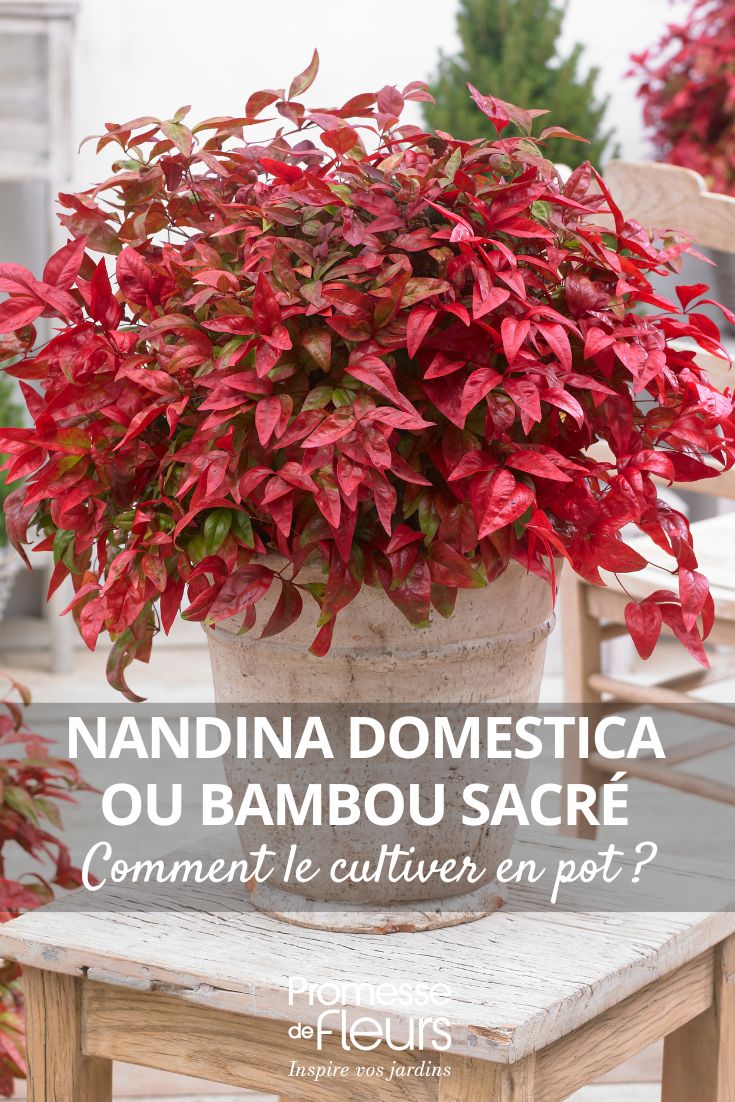































Comments